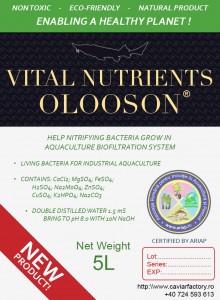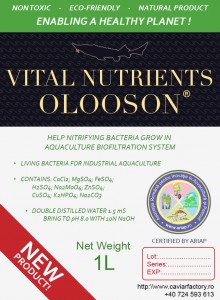Micronutrients
Contains:
CaCl2; PO4; MgSO4; Feso4; H2SO4; Na2MoO4; Znso4; CuSO4; K2hpo4; Na2CO3; and other… Double-Distilled Water bring to pH 8.0 with NaOH 10N
All species of bacteria nitrificatoare requires a series of micro-nutrients. The most important of these is the phosphorus needed for the production of ATP (adenosine Tri-phosphate). The conversion of ATP provides energy for cellular functions. Phosphorus is normally available within cells in the form of phosphate (PO4). Nitrobacter, especially, is unable to oxidize nitrites the lack of phosphates. In water are generally present sufficient phosphate amount. At certain times of the year, the amount of phosphates may be very small. A phenomenon known as “Blocking Phosphates” may occur. Where we use a biofilter inocula for startup or when the water does not provide good conditions for the development of bacterial nitrifing bacteria for nutrients are a real help.
Setpoints have to be careful in your work do not miss metals needed for the manufacture of enzymes and proteins in the process
Ammonium oxidation is a biochemical process that can occur only in the presence of specific enzymes, proteins and in the presence of oxygen. The main enzymes needed to achieve these changes and generate energy during the oxidation of ammonia to nitrite are called ammonia mono oxygenase enzyme (AMO) and hydroxylamine reducing oxidation (HAO). The first enzyme is catalyzed by a protein containing copper in its trans-membrane celular structure. In the second step of nitrification a triple protein structure converts into periplasm hydroxylamine nitrite, hence the four electrons. The flow delivery of these four electrons is done through the channel that is connecting the cytochrome (lightweight proteine) to the protection membrane of the cytochrome. Two of the electrons return in AMO and the other two are used to produce a proton that is forcing and reducing back the restoring force of the electrons.
NH3 + O2 → NO-
2 + 3H + 2e- (1)
NH3 + O2 + 2H + + 2e- + H2O → NH2 OH (1.1)
NH 2 OH + H2O → NO-
2 + 5H + + 4e- (1.2)
The second step of nitrification – the molecular mechanism
Nitrites produced in the first step of nitrification are, in their turn, oxidized to a form of nitrates by the nitrites redox (NXR) (2). In fact it is a membrane that has proteins containing iron, sulfur, molybdenum, chromium, zinc and over 10 other chemical components. Their weight is finely determined by the molecular mechanism that oxidizes nitrite to nitrate levels and it is today the subject of research by scientists such as polish Andrzej Woźnica who in 2013 proposed a new hypothetical chain linking model between the NOB type model and the membrane NXR type mechanism.
NO-
2 + H2O → NO-
3 + 2H + + 2e- (2)

